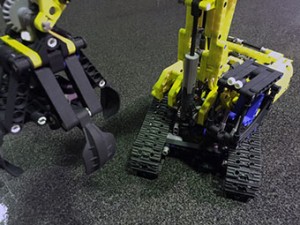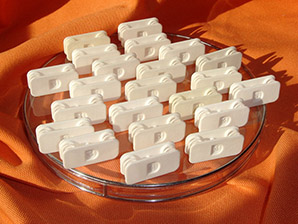3D Prototype Design has been working with SLS technology since 1999 and as a result has built a strong reputation for providing exceptional nylon parts. SLS supplies the best that 3D printing can offer including durable, functional and flexible parts, multiple pieces as well as parts that can be tapped, drilled, snap-fit and sterilized.
SLS Printing Process
Selective Laser Sintering uses a CO2 laser to fuse powdered materials. As the laser contacts the powder bed, it raises the material to its sintering temperature to create a layer of solid part geometry.
- STL CAD file is sliced to create layers
- Laser draws the bottom-most layer
- Powder is spread over completed layer
- The process is repeated for subsequent layers
- Upon completion, the powder cake is removed
- Part is extracted from the loose powder
As the CO2 laser scans across the powder bed, it brings the material to the melting point. At this temperature, individual particles bond at their contact points to solidify a layer of the prototype. The depth to which the powder solidifies is a function of laser power and material sintering temperature. Solidifying a single layer is controlled by passing the laser over the powder bed at a speed that imparts the necessary level of energy.
SLS Printing In Laymen’s Terms
 In other words, in a computer software program we take your parts and slice them into layers that are .004” thick (approx. 2 hairs)*. The SLS machine is heated up, the building bed drops by .004” (one slice of your parts) and the roller lays out a layer of power material (such as nylon or rubber-like).
In other words, in a computer software program we take your parts and slice them into layers that are .004” thick (approx. 2 hairs)*. The SLS machine is heated up, the building bed drops by .004” (one slice of your parts) and the roller lays out a layer of power material (such as nylon or rubber-like).
Here’s when the term selective laser sintering comes into play — the laser then goes across the building bed area and selectively sinters (flash melts the slice) making the solid areas solid, one slice at a time. Whatever doesn’t get melted remains as a powder and acts as the support structure.
This process will continue layer by layer until the parts are done. Once the build is complete and the bed has cooled down, a technician removes the block of powder; digs through it like an archaeological dig to find the solid pieces, then removes and cleans away the loose powder around the parts. The parts are now ready for use or post-colouring.
- Fully functional, durable prototypes (like an injection molded plastic part when nylon is used)
- Nylon material parts can be tapped, drilled, snap fit, assembled and painted
- Living hinges and functioning springs can be produced, fluids can be run through them
- Rapidly produces one or multiple pieces (up to hundreds or thousands, dependent on size)
- In addition to nylon, this process also offers glass-filled nylon, carbon fiber, rubber-like and metal materials
 *3D Prototype Design builds only at 0.004” to offer the best resolution available to our customers. The typical layer thickness for the Selective Laser Sintering process is between 0.004” and 0.006”
*3D Prototype Design builds only at 0.004” to offer the best resolution available to our customers. The typical layer thickness for the Selective Laser Sintering process is between 0.004” and 0.006”
To learn more about the various 3D printing technologies that are available to you or to determine whether SLS printing is the best method for your prototype, please contact us for more information or request a quote.

